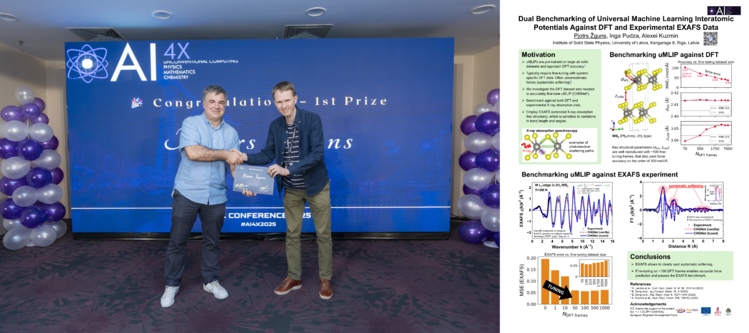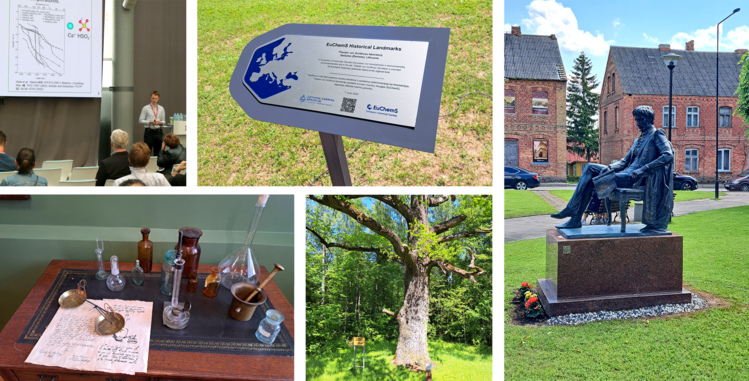
Title: Combining Machine Learning Interatomic Potentials With X-Ray Absorption Spectroscopy to Resolve the Structure–Property Relationship in Functional Oxides
Research proposal No: 1.1.1.9/LZP/1/24/016
Duration: 01.03.2025.-29.02.2028.
Project Leader: Pjotrs Žguns
Total budget: 185 510 EUR
European Regional Development Fund (ERDF) funding: 157 683.50 EUR
ISSP UL budget: 9275,50 EUR
Project description:
Advanced functional materials, such as photochromic and thermochromic oxides, have a wide range of functional capabilities and are of great interest for practical applications. However, understanding their structure–property relationships has been challenging and remains an open research quest. In this project, we propose to address this issue using a combination of locally sensitive X-ray Absorption Spectroscopy, specifically Extended X-ray Absorption Fine Structure (EXAFS), and Molecular Dynamics (MD) simulations based on Machine-Learning Interatomic Potentials (MLIPs). While EXAFS spectroscopy is a powerful experimental tool for probing the local atomic structure, it is plagued by ill analysis of spectra. To overcome this, we will apply cost-effective MD simulations based on MLIPs, which provide first-principles accuracy, to generate theoretical EXAFS spectra and validate them against experimental data for functional oxides. The results of this project will shed light on the atomistic structure of photochromic and thermochromic oxides, enabling further improvements in their performance.
PROJECT PROGRESS
Time period: 01.03.2025 – 31.08.2025
In the first six months of the project, we showed that cost-effective universal Machine Learning Interatomic Potentials (uMLIPs) can produce high-quality theoretical EXAFS spectra via MD and validated this approach against experimental data. We also demonstrated that experimental EXAFS data can benchmark uMLIPs and guide dataset selection for fine-tuning, leveraging the high sensitivity of EXAFS to thermal disorder. These results provide a foundation for benchmarking the growing range of uMLIPs and, thanks to their cost-effectiveness, should promote wider use of MD for EXAFS interpretation—ultimately improving the accuracy and reliability of spectra analysis. For details, please see our recent paper:
P. Žguns, I. Pudža, A. Kuzmin, Benchmarking CHGNet Universal Machine Learning Interatomic Potential against DFT and EXAFS: The Case of Layered WS2 and MoS2, J. Chem. Theory Comput., accepted (2025), https://doi.org/10.1021/acs.jctc.5c00955
These results were presented at two conferences:
1) Machine Learning for Materials Discovery, Aalto, Finland, 5–8 May 2025 (oral talk)
2) AI4x, Singapore, 8–11 July 2025 (poster)
The poster won 1st prize award at AI4x, the world’s largest AI conference revolutionizing Natural Sciences.
I also had the honor of participating in the Grotthuss Conference (Vilnius, June 4–6) and delivering an invited talk on fast solid-acid proton conductors. One of the key points of my talk was a demonstration of how cost-effective MLIPs accelerate materials modeling.
Additionally, I attended the ceremony commemorating the heritage of Theodor Grotthuss, which included the unveiling of a plaque by the European Chemical Society, highlighting his home laboratory in Žeimelis (Lithuania). Grotthuss, one of the founders of electrochemistry, received outstanding education and training at Europe’s leading universities, where he also carried out pioneering work. After returning home, he continued his experiments at his manor, located about 200 km north of Vilnius and 100 km south of Riga. In opening remarks, Prof. Richard Compton (Oxford) emphasized Grotthuss’s significant contributions to electrochemistry and illustrated how the passion of a single person can drive scientific progress. Today, an improvised, education-oriented Grotthuss lab in the center of Žeimelis attracts schoolchildren from nearby areas and aims to inspire their interest in STEM, fostering curiosity and innovation.
During this period, I also learned EXAFS from a practical perspective and visited the DESY synchrotron (Hamburg), gaining valuable insights into how experiments are conducted at the beamline.


